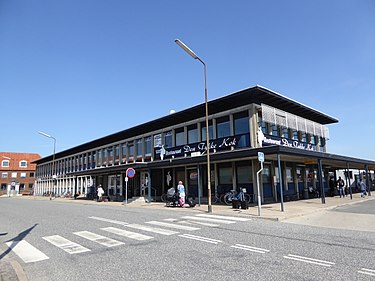
425 applicants. 36 admitted. The numbers speak for themselves.
The architectural program in Kalundborg has cemented its status in the city even before it started.
The new students are selected from a total of 425 applicants for the program with a grade point average of 10.1 in quota 1.
Dean of Architecture at the Royal Danish Academy, Jakob Brandtberg Knudsen, is very pleased with the positive result:
"We are pleased that there are once again high numbers of applicants for the entire Royal Academy, but especially for the program in Kalundborg. It is a pleasure that future students can see potential in the program and in the city. In Kalundborg, the new students will have the opportunity to experiment in many areas and in close collaboration with local partners," he says and continues:
"The location of the station building in the middle of the city suits us perfectly. From here, the new architecture program can get off to a good start, and we can enter into a close dialog with the citizens and the city. It is crucial for the Royal Academy that the program has a local connection, and we believe this will strengthen the success and quality of the program in the long term."
The program in Kalundborg meets all the same national and international requirements as the architectural program in Copenhagen and has the same quality standards.
"It seems that we have attracted some very qualified students to Kalundborg, and we are of course very pleased with that. We hope that this also reflects a desire to be pioneers in a new education with many opportunities."
Jakob Brandtberg Knudsen, Dean of Architecture at the Royal Academy
When the program is fully phased in, there will be a total of around 140 architecture students in Kalundborg.
In Kalundborg, the program focuses on how landscapes and buildings can be shaped and developed to be both attractive and sustainable.
"It is really positive that more new study places have been created, as there is a need for sharp young people for the green transition. Architects in particular have many new solutions to reduce CO2 emissions, both in relation to recyclable materials, new construction, conversion of older buildings and sustainable development of cities and rural areas",
Jakob Brandtberg Knudsen, Dean of Architecture at the Royal Academy

Aerial view of another educational center in Kalundborg, Helix Lab and Campus Kalundborg, next to the Biotech City industry.
Urban development in Kalundborg is in line with the city's growing industry and educational offerings, which Knowledge Hub Zealand is working to strengthen.
We work purposefully to attract and support business-relevant higher education in Region Zealand, and we have done so in collaboration with the Royal Danish Academy. Academy.
The program was formally approved in January 2023.

Knowledge Hub Zealand
Biotekparken 1
4400 Kalundborg



Knowledge Hub Zealand
Biotekparken 1
4400 Kalundborg